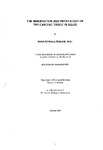THE INNERVATION AND PHYSIOLOGY OF THE CARDIAC TISSUE IN SQUID
| dc.contributor.author | ODBLOM, MARIA PERNILLA | |
| dc.contributor.other | School of Biological and Marine Sciences | en_US |
| dc.date.accessioned | 2013-11-01T13:09:03Z | |
| dc.date.available | 2013-11-01T13:09:03Z | |
| dc.date.issued | 1997 | |
| dc.identifier | NOT AVAILABLE | en_US |
| dc.identifier.uri | http://hdl.handle.net/10026.1/2545 | |
| dc.description.abstract |
Cephalopods have one of the most sophisticated cardiovascular systems among the invertebrates; they have an enclosed high pressure blood system, characterised by a double circulation, with one main systemic heart and two gill hearts. The cephalopod cardiac tissues are basically myogenic, but there is evidence for both nervous and hormonal regulation of most parts of the cardiovascular system, although the details of the control systems remain unknown. This study investigated the physiology and innervation of the cardiac tissues of the squid Alloteuthis subulata, Loligo forbesii and L vulgaris. Histological staining techniques established that the cardiac organs in squid are innervated from the palliovisceral lobe of the brain via the paired visceral nerves. The nerves to the ventricle, branch off from each of the visceral nerves, close to a commissure that connects the two visceral nerves. The auricles of the systemic heart are innervated from a cardiac ganglion, situated at the base of the gills. Other branches, also given off at this level, innervate the lateral vena cava, afferent and efferent branchial blood vessels, branchial hearts and the muscular valve region between the branchial heart and afferent branchial vessel. Electron microscopical studies have shown the structure and number of fibres in these nerves. Pharmacological studies of isolated and perfused squid branchial hearts showed that acetylcholine had an inhibitory effect on cardiac activity, acting on both nicotinic and muscarinic receptors. An aminergic receptor system may be present in squid branchial hearts, although the transmitter substance is still unknown. The catecholamines adrenaline and noradrenaline excite the heart, although in an inconsistent manner. Whole cell patch clamp studies revealed that individual squid heart cells operated, using a combination of at least six different ionic currents; three outward potassium currents (delayed rectifier, A-current, calcium-activated current) and three inward currents (sodium current, L- and T -type calcium currents). An understanding of the functions of the various currents was obtained by recording electrically stimulated and spontaneous action potentials, using conventional intracellular recording and stimulation techniques. The ionic currents were isolated by applying known channel antagonists, and each antagonist's effect on the action potential was studied. | en_US |
| dc.description.sponsorship | The Marine Biological Association | en_US |
| dc.language.iso | en | en_US |
| dc.publisher | University of Plymouth | en_US |
| dc.title | THE INNERVATION AND PHYSIOLOGY OF THE CARDIAC TISSUE IN SQUID | en_US |
| dc.type | Thesis | |
| plymouth.version | Full version: final and full version as approved by the examiners at the time of the award of your degree | en_US |
| dc.identifier.doi | http://dx.doi.org/10.24382/3740 | |
| dc.identifier.doi | http://dx.doi.org/10.24382/3740 |
Files in this item
This item appears in the following Collection(s)
-
01 Research Theses Main Collection
Research Theses Main


